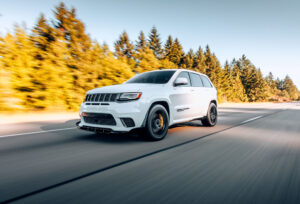The Jeep Cherokee, an iconic SUV, has been a symbol of adventure and versatility for decades. In this article, we’ll dive deep into how the Cherokee has evolved, examining its design, technology, and performance changes. Our goal is to provide a comprehensive view of this legendary vehicle, from its inception to its current status in the automotive world.
The Birth and Early Years of the Jeep Cherokee (1974-1983)
The Jeep Cherokee began as a two-door version of the Wagoneer and quickly set a standard for SUVs with its robust design and capability.
The Original SJ Model
Introduced in 1974, the Jeep Cherokee SJ was essentially a two-door version of the Wagoneer. It was designed for rugged utility, boasting powerful engines like the AMC V8s. Its design was straightforward yet functional, appealing to those needing a vehicle for work and play.
Paving the Way for Modern SUVs
This era’s Cherokee played a crucial role in defining the SUV segment. Its blend of practicality and off-road capability resonated with consumers, setting the stage for the future of sport utility vehicles.
The Introduction of the Jeep Cherokee XJ: A Revolutionary Design (1984-2001)
The Cherokee XJ brought a revolutionary compact design and unibody construction, making it lighter and more efficient.
The Compact and Innovative XJ
The Cherokee XJ was a game-changer. Launched in 1984, it was smaller than its predecessor but didn’t sacrifice power or off-road ability. Its unibody construction was a first in the SUV segment, contributing to its lighter weight and increased fuel efficiency.
Technological Advancements and Design Tweaks
Over the years, the XJ saw numerous updates. From interior redesigns to introducing advanced 4×4 systems, it continually adapted to meet consumer demands while maintaining its rugged charm.
The Jeep Cherokee’s Journey into the New Millennium (2002-Present)
The new millennium brought more refined designs and advanced technology to the Jeep Cherokee, aligning with modern demands.
The Launch of KJ and Later Models
Post-2001, the Jeep Cherokee transitioned into the KJ model and beyond, featuring a more rounded design and improved on-road performance. These changes reflected the evolving market, emphasizing comfort without compromising the Jeep’s signature off-road capabilities.
The Modern Jeep Cherokee: Advanced Technology and Luxury Features (2014-Present)

Since 2014, the Jeep Cherokee has embraced a new era of sophistication and technological advancement. Here’s an in-depth look at how these models stand out:
Luxury and Technology in the Latest Models
- Introduction of Advanced Infotainment Systems:
- Touchscreen displays with user-friendly interfaces.
- Integration with smartphones via Apple CarPlay and Android Auto.
- Premium sound systems for an immersive audio experience.
- Enhanced Driver-Assist Features:
- Adaptive Cruise Control: Maintains a set distance from the vehicle ahead.
- Lane Departure Warning: Alerts the driver if the vehicle begins to drift out of its lane.
- Blind Spot Monitoring: Detects and alerts drivers to vehicles in their blind spot.
- Rear Cross Traffic Alert: Assists in detecting vehicles while reversing.
- Forward Collision Warning with Active Braking: Helps prevent accidents by alerting the driver of potential collisions.
- Improved Interior Comfort:
- Luxurious leather upholstery options.
- Heated and ventilated front seats for year-round comfort.
- Spacious cabin with ample legroom and headspace.
- Dual-zone automatic climate control for personalized comfort.
- Versatile for Urban and Off-Road Use:
- Smooth handling and comfortable ride quality in city driving.
- Robust suspension and 4×4 systems capable of tackling challenging off-road terrains.
Hybrid Technology and Eco-friendly Options
- Introduction of Hybrid Models:
- Combination of traditional combustion engine and electric motor.
- Improved fuel efficiency, reducing carbon footprint.
- Regenerative braking system, converting kinetic energy into electric power.
- Eco-Friendly Driving Experience:
- Lower emissions compared to traditional gasoline-only models.
- Multiple driving modes including a fuel-efficient setting.
- Quiet electric motor operation, especially beneficial in urban settings.
- Balancing Power and Sustainability:
- The hybrid system does not compromise the vehicle’s power and performance.
- Provides a smooth transition between electric and gasoline modes.
- Ensures consistent performance both in city driving and off-road conditions.
The modern Jeep Cherokee models are a testament to Jeep’s commitment to innovation. They skillfully blend luxury features and advanced technology, offering drivers a sophisticated, eco-friendly driving experience. Whether navigating city streets or exploring rugged terrains, these models demonstrate Jeep’s ability to evolve and adapt, ensuring a top-notch experience for all types of drivers.
Comparing Performance: Jeep Cherokee Through the Decades
The Jeep Cherokee’s journey through the decades showcases a significant evolution in performance and efficiency. Every generation has introduced enhancements, adapting to the changing needs and expectations of drivers.
Performance Metrics Comparison
- The SJ Models (1974-1983):
- Engine Performance: Early SJ models were equipped with powerful AMC V8 engines, known for their robust performance.
- Fuel Efficiency: These models were less focused on fuel economy, reflecting the era’s less stringent fuel consumption concerns.
- Handling: With a traditional body-on-frame design, these Cherokees offered a rugged, durable driving experience, though not as refined as later models.
- The XJ Models (1984-2001):
- Engine Performance: Introduction of more efficient 4-cylinder engines alongside the traditional 6-cylinder options. This range provided a balance between power and economy.
- Fuel Efficiency: The XJ’s unibody construction significantly reduced weight, contributing to better fuel economy compared to its predecessors.
- Handling: Improved significantly with the unibody design, providing a smoother ride and better on-road dynamics.
- The KJ Models (2002-2007) and KK Models (2008-2013):
- Engine Performance: Introduction of modern V6 engines, offering more power with better fuel economy than earlier V8s.
- Fuel Efficiency: Continued improvements in fuel efficiency, with advances in engine technology and aerodynamic design.
- Handling: These models offered a more car-like driving experience, with improvements in suspension and steering for a more comfortable ride.
- The KL Models (2014-Present):
- Engine Performance: Latest models feature even more efficient engines, including turbocharged options and, eventually, hybrid powertrains.
- Fuel Efficiency: Significant strides in fuel efficiency, benefiting from modern engine technologies and lightweight materials.
- Handling: Enhanced with contemporary suspension systems, offering a balance between off-road prowess and smooth on-road performance.
Evolution Reflecting Jeep’s Commitment
- Technological Advancements: Each generation of the Cherokee has incorporated the latest in automotive technology, ensuring performance keeps pace with or exceeds industry standards.
- Adaptation to Market Trends: From raw power in the early years to a more balanced approach in recent models, the Cherokee’s evolution mirrors changing market demands and consumer expectations.
- Balancing Off-road and On-road Performance: A constant throughout the Cherokee’s evolution is its ability to handle off-road conditions while providing a comfortable on-road experience.
This performance comparison across decades illustrates how the Jeep Cherokee has remained a relevant and competitive player in the ever-evolving automotive world. Its ability to adapt and improve, without losing sight of its core attributes of reliability and versatility, continues to endear it to a broad spectrum of drivers.
Jeep Cherokee’s Off-Road Capabilities: A Legacy Continued
The Jeep Cherokee has consistently maintained its reputation for exceptional off-road capabilities.
Evolution of 4×4 Systems
Each generation of the Cherokee has seen advancements in its 4×4 systems, ensuring superior off-road performance. These improvements have kept the Cherokee at the forefront of off-road capability in the SUV segment.
Cultural Impact and Popularity of the Jeep Cherokee
The Jeep Cherokee has had a significant cultural impact, becoming a symbol of adventure and reliability.
The Cherokee in Popular Media and Culture
The Cherokee’s presence in movies, television, and as a part of popular culture underscores its enduring appeal. It has become more than just a vehicle; it’s a symbol of adventure and freedom.
Jeep Cherokee Fan Base: A Community of Enthusiasts
The Jeep Cherokee has a passionate fan base, forming a community that celebrates this iconic vehicle.
Clubs, Forums, and Events
Across the globe, Cherokee enthusiasts have formed clubs, online forums, and organized events. These communities not only share a passion for the vehicle but also influence its ongoing development and iterations.
FAQs for Jeep Cherokee over the years
What makes the Jeep Cherokee a popular choice among SUVs?
The Cherokee’s blend of off-road capability, reliability, and evolving technology make it a standout in the SUV segment.
How has the Jeep Cherokee’s safety features evolved?
Over the years, the Cherokee has incorporated advanced safety features like airbags, anti-lock brakes, and electronic stability control.
Can the Jeep Cherokee compete with newer SUV models?
Absolutely. With continual updates and improvements, the Cherokee remains competitive in the market.
What are the significant changes in recent Jeep Cherokee models?
Recent models have emphasized eco-friendly technology, enhanced safety features, and improved interior luxury.
Conclusion
The Jeep Cherokee’s evolution is a testament to its enduring legacy in the automotive world. From its rugged early models to the luxurious and technologically advanced versions of today, the Cherokee has consistently adapted to meet the needs of its diverse fan base. As we look to the future, the Jeep Cherokee is poised to continue its legacy of innovation and adventure.

Hello there, this is Thomas Byrd. I am a professional car mechanic who leads a team of junior mechanics in a repair and restoration shop. In the beginning, I used to work for a jeep service center as a basic worker. From there I keep learning, changed my job 2 times and now I am a professional who leads a group of mechanics. Though a have expertise in the jeep, I know very well about all types of cars. To share my knowledge and skills with others I have created this blog website. Whenever I get free time from work I give my time to my blog.

